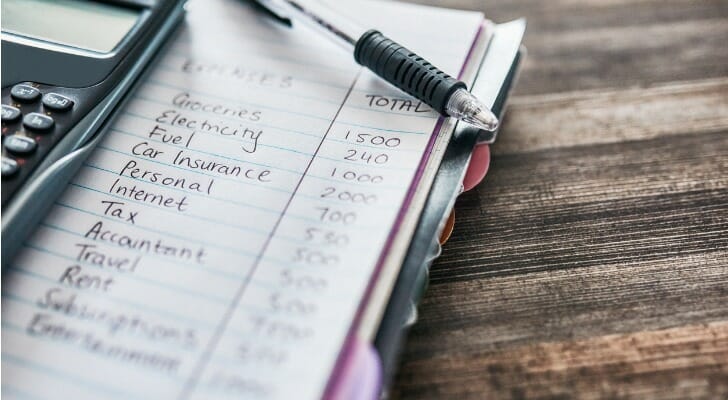“Pay yourself first,” also known as “reverse budgeting,” is a budgeting method designed to prioritize your personal financial goals. Instead of focusing first on paying bills and discretionary spending, this approach ensures that savings and investments are made a priority. After setting aside funds for your goals – whether it’s retirement savings, an emergency fund or other financial targets – your remaining income is allocated to cover your living expenses. This method can be effective for individuals who want to stay disciplined about saving, and works well when combined with automated transfers into savings or investment accounts, allowing you to effortlessly grow your wealth without the temptation to overspend.
Setting spending and saving goals can be tricky, which is why working with a financial advisor can make a big financial difference for you.
What Is Pay Yourself First?
Ordinary budgeting is built on an expenses-up model. You take your income, subtract your various expenses, and build any savings and financial goals from there. Adjusting your finances works the same way. You shift your expenses, then make any necessary financial changes.
Pay yourself first reverses this approach. With a pay yourself first budget, you focus on your personal savings and financial goals. This is the foundation of the budget. After portioning out money for these goals, then you allocate money and structure your expenses accordingly. This makes your financial planning forward looking, focusing on the things you want to do with your money, rather than backward looking and focused on the ways you’ve already spent or committed your money.
How Does Pay Yourself First Work?

Paying yourself first is counterintuitive for most people. It’s far more common to build a budget around your bills, which are typically due monthly, and short-term debt. So at first this will take some very intentional planning. To do it, think through the following four steps:
Set financial goals: Pay yourself first means building your money around your overall financial goals. To start with, you should figure out those priorities. How much do you want to put toward retirement? How much do you want to put toward long-term savings? Do you have any other long-term goals that you want to set aside money for? For example, are you saving up to buy a house, take a vacation or fund a college account?
Not all of these goals have to be traditional. Just remember: These aren’t your short-term goals. They’re the big things you want to accomplish over a period of years.
Budget for long-term goals: Now that you know what you want to do with your money, figure out how to divide it up. Most people begin with what’s known as the 50/30/20 method: Put 50% of your money to essentials (bills, housing, debt.), 30% of your money to wants and discretionary spending and 20% of your money to savings. This is at least a good place to start.
Decide how much of your monthly income to dedicate to each category of long-term savings. Will you put aside, for example, 5% or 10% of what you earn to a retirement account? Do you want 5% set aside for long-term savings, or maybe another 10% for the housing fund? Try to figure out numbers that work for your long-term goals in the context of your monthly income.
Structure spending around your goals: This is the part that may require some time to act on. Once you understand how much money you want to put toward your long-term goals each month, you’ll have a sense of how much is left over. Now you need to figure out how much of that you want to divide between discretionary spending (entertainment, hobbies, general pocket money) and your monthly bills.
For bills, make sure to account for everything you need to spend. How much money do you want to spend on rent each month? On food and utilities? How much do you need for fixed monthly payments like debt? In most cases, pay yourself first puts debt as a monthly bill rather than a financial goal. However, you can decide to make paying down debt its own financial priority. In this case, you would decide how much money you want to spend each month getting out of debt. This is a long-term goal, and a very good one at that.
This is where pay yourself first varies the most from traditional budgeting. Ordinarily, you would start with these expenses. You would look at how much your car and apartment cost, then from there decide how much you can afford in discretionary spending and savings. Pay yourself first looks at it from the other direction. Once you understand your long-term financial goals, you can build a lifestyle around that. If you set aside 10% of your income to retirement and another 15 for other long-term goals, how much apartment can you afford? If you want to put aside $50,000 for a down payment on a house, how does that change what kind of monthly bills you rack up?
Adjust your plan as needed: Of course, the first draft of your budget may not work. Once you have finished setting up goals, take a realistic look at how you’ve balanced your money. For example, have you cut discretionary spending to the bone? That probably won’t be a sustainable financial model – unless your committed to a radical lifestyle change – nor will it be a pleasant way to live your life. Is your housing budget unrealistic, or did you not leave enough room for mandatory payments such as housing and debt?
Adjust your long-term goals based on what you need to meet short-term needs and wants. It’s important that you don’t get so ambitious with long-term planning that you fail to meet your immediate obligations. Of course, at the same time, make sure to keep your long-term goals as the first priority. Otherwise you’ll defeat the whole purpose of this exercise.
Pay Yourself First: An Example
Let’s say you make $4,000 per month after taxes and decide to set up a budget around paying yourself first. You might run through our four steps as they are laid out below.
Set financial goals: You want to save for retirement, build up an emergency fund, and start saving to buy a house. These are your long-term goals that you will prioritize. You want to save for retirement, build up an emergency fund and start saving to buy a house. These are your long-term goals that you will prioritize.
Budget for long-term goals: You decide to budget 25% of your income per month to long-term goals. Specifically you will dedicate 10% for retirement, 5% for the emergency fund and another 10% for the house. This gives you: $400 + $200 + $400 = $1,000 per month toward long-term savings.
Structure spending around your goals: You have $3,000 left after identifying your long-term goals. You live in Cambridge, outside of Boston, where you pay the average rent of $2,500 for a one-bedroom apartment. You also have another $500 per month in student loans, a $100 monthly phone bill and $200 in combined utilities. Your car payments come to another $200 per month plus $60 per month of insurance. This leads to a combined $3,560 per month in fixed expenses. You would also like to set aside 20% of your income ($800 per month) for discretionary spending, short-term savings, travel, entertainment and other general spending money.
Adjust your plan as needed: So you need to make some adjustments. Your long-term goals ($1,000) plus discretionary budget ($800) plus current spending ($3,560) comes to a combined $5,560. This is significantly more than you make already, meaning that you need to cut $1,560 from this budget.
- Housing: If you want to hit your long-term goals you can’t keep living your current lifestyle, so you need to move. By moving to a cheaper neighborhood in Boston you can find an apartment for $1,800. You might also decide that living in the city means you no longer need your car, which can save you another $260 per month. Student loans are likely non-negotiable as, most likely, are your utility bills. This cuts $960 from your current spending, bringing that category down to $2,600 per month.
- Discretionary spending: Now you adjust the discretionary budget, down to $600 per month on various short-term want and needs. Remember, this isn’t just your dining-out money. It’s everything you spend money on outside of planned, structured bills. Don’t cut this category too close to the bone or you might find yourself in trouble. This brings the current and discretionary budget to a total $3,200 per month.
- Long-term goals: Your retirement plan is solid, but you might save only $200 per month for a house. That puts your long-term savings at $800 per month, allowing you to create a budget that both meets your current needs and still starts building toward long-term goals.
What Percentage of Americans Are Saving Money?
In 2023, a Federal Reserve report revealed that over a third (37%) of Americans would be unable to cover a $400 emergency in cash or its equivalent. This figure remains unchanged from 2022 but is slightly higher than in 2021, when 32% of Americans reported the same. Additionally, 34% of people in 2023 felt their retirement savings were on track, a similar percentage to 2022 (31%), though notably lower than the 40% reported in 2021.
Bankrate’s Annual Emergency Savings Report offers further insight into Americans’ financial preparedness. Over 27% of respondents admitted to having no emergency savings, while 29% reported having less than three months’ worth of living expenses. Around 16% had savings covering three to five months of expenses, and 28% had enough to cover six months or more. The report also highlighted generational differences: nearly half (46%) of Baby Boomers had six months or more in emergency savings, compared to 25% of Gen X, 20% of Millennials, and just 11% of Gen Z.
Bottom Line

Pay yourself first is a form of budgeting that focuses around setting up a lifestyle and bills around your long-term savings. The benefit of pay yourself first is that it lets you structure your spending around your financial goals, rather than the other way around. Many people will adjust their long-term plans based on their lifestyle, but this approach to budgeting says that you should adjust your lifestyle to your long-term plans. It might take some time to establish, and it’s certainly not foolproof, but it can be an excellent way of achieving your goals.
Tips on Finances
- Should you pay yourself first? How can you structure your savings to get more out of each month? What can you do to trim some of those expenses and debt? While good personal finances can help with this, there’s nothing like sound professional advice to get it right. Finding a financial advisor doesn’t have to be hard. SmartAsset’s matching tool can help you find a financial advisor in your area to help you build the right budget for you. If you’re ready, get started now.
- With our free interactive budget calculator you can see how people like you in your zip code are budgeting based on factors including the number of adults and children in the household and the size of the household’s annual income.
Photo credit: ©iStock.com/Tinpixels, ©iStock.com/Moyo Studio, ©iStock.com/SelectStock
